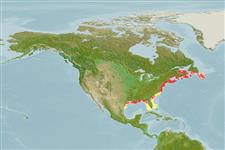Classification / Names
Common names from other countries
Main reference
Size / Weight / Age
Max length : 200 cm TL male/unsexed; (Ref. 5723); common length : 120 cm TL male/unsexed; (Ref. 9988); max. published weight: 57.0 kg (Ref. 2850); max. reported age: 30 years (Ref. 1468)
Environment
Marine; freshwater; brackish; demersal; anadromous (Ref. 51243); depth range 30 - ? m (Ref. 2850)
Climate / Range
Temperate; 8°C - 25°C (Ref. 47172), preferred 20°C (Ref. 107945); 47°N - 24°N, 94°W - 58°W
Distribution
Western Atlantic: St. Lawrence River in Canada to St. John's River in northern Florida and northern Gulf of Mexico; from fresh and brackish tributaries of western Florida to Louisiana in the USA. Introduced to other countries.
Countries | FAO areas | Ecosystems | Occurrences | Introductions
Short description
IUCN Red List Status (Ref. 115185)
Threat to humans
Harmless
Human uses
Fisheries: minor commercial; aquaculture: commercial; gamefish: yes
Tools
Special reports
Download XML
Internet sources
Estimates of some properties based on models
Phylogenetic diversity index
PD50 = 0.5781 many relatives (e.g. carps) 0.5 - 2.0 few relatives (e.g. lungfishes)
Trophic Level
4.7 ±0.2 se; Based on diet studies.
Resilience
Low, minimum population doubling time 4.5 - 14 years (K=0.12; tm=5-7; tmax=30; Fec=14,000)
Vulnerability
High vulnerability (61 of 100)
Price category
